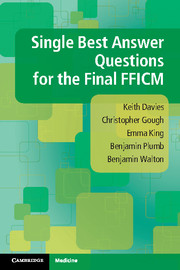Book contents
- Single Best Answer Questions for the Final FFICM
- Single Best Answer Questions for the Final FFICM
- Copyright page
- Contents
- Preface
- Exam A: Questions
- Exam A: Answers
- Exam B: Questions
- Exam B: Answers
- Exam C: Questions
- Exam C: Answers
- Exam D: Questions
- Exam D: Answers
- Exam E: Questions
- Exam E: Answers
- Exam F: Questions
- Exam F: Answers
- Exam G: Questions
- Exam G: Answers
- Exam H: Questions
- Exam H: Answers
- Index
- References
Exam D: - Answers
Published online by Cambridge University Press: 21 January 2017
- Single Best Answer Questions for the Final FFICM
- Single Best Answer Questions for the Final FFICM
- Copyright page
- Contents
- Preface
- Exam A: Questions
- Exam A: Answers
- Exam B: Questions
- Exam B: Answers
- Exam C: Questions
- Exam C: Answers
- Exam D: Questions
- Exam D: Answers
- Exam E: Questions
- Exam E: Answers
- Exam F: Questions
- Exam F: Answers
- Exam G: Questions
- Exam G: Answers
- Exam H: Questions
- Exam H: Answers
- Index
- References
Summary
A 28-year-old man has been admitted to intensive care with severe respiratory failure. He is sedated and ventilated. A viral throat swab confirms the presence of influenza A, and a diagnosis of viral pneumonia is made.
- Type
- Chapter
- Information
- Single Best Answer Questions for the Final FFICM , pp. 142 - 178Publisher: Cambridge University PressPrint publication year: 2016

